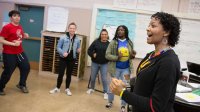Supporting Students During Uncertain Times
Motivating students starts with knowing what you want them to take away from lessons and finding ways to incorporate their interests.
Your content has been saved!
Go to My Saved Content.The joy of being back together this school year has been tempered by pandemic mandates, differing opinions about compliance, and school systems marching on as if everything were business as usual. These realities are leaving students and teachers to deal with revolving quarantines, varying degrees of masking and distancing, and the looming concern of a sudden pivot to virtual instruction.
When deciding how to best support ourselves and our students, we can look to the advice of Edutopia’s chief content officer, Stephen Merrill: “The need to rebuild the frayed social fabric of our learning communities... should be the paramount concern.” With that in mind, we can support both ourselves and our students by centering healing and connection in our classrooms with the guiding principles discussed here.
Prioritize Relevance
This year more than ever, in order to keep students motivated, we need to engage them in work that’s relevant to their lives. In planning, it’s helpful to consider the following questions:
- What do I want students to know and do as a result of my teaching?
- How can they demonstrate their understanding in ways that align with their interests?
Once you’ve answered these questions for yourself, you and your students can cocreate richer and more expansive opportunities when you ask them this: What are some ways you can demonstrate these understandings that align with your passions and interests?
Another way to ensure that the work in your classroom is relevant to students is to give them time for inquiry and introspection that can inform instructional choices. One idea is to have students explore their identities or, as English teacher Daniel Valentin suggests, curate a Spotify playlist or their Netflix queue and identify what these selections say about them and how the lyrics or stories reflect their lives.
With this type of insight from our students, not only can we adapt our lessons for the students in front of us, but also we can ensure a smooth-running classroom with minimal disruptions because students are actively engaged in work that matters to them.
Nurture Synergy
Continually creating space to build community can fortify and sustain us through this unpredictable school year. One way to strengthen our connections with students is to conduct frequent check-ins. When we inquire about students’ academic progress, we can ask questions like these:
- In what areas do you feel you are doing well?
- Are there any topics that are causing you to struggle?
- What can I do to support you as a student?
We can also elicit feedback from our students about how they’re feeling in our classroom. John Hattie offers seven Cs of classroom climate that you can use to survey students. If the results identify areas where teachers can better meet students’ needs, invite them to offer suggestions so that together you can determine ways to improve on this.
This feedback and the subsequent conversations have the multiplying effect of building community; supporting students’ social, emotional, and academic needs; and providing actionable feedback. In Healing, Community, and Humanity: How Students and Teachers Want to Reinvent Schools Post-Covid, Justin Reich and Jal Mehta write, “Addressing healing, community and humanity is not peripheral to the academic mission of school, it is a vital part of such a mission.”
Additionally, the responses can inform our planning, how we need to differentiate, and when our students might benefit from a referral to a school counselor because their needs extend beyond what we can offer.
Cultivate Joy
As the return to in-person instruction has given many of us the opportunity to heal from the trauma of being separated, culturally responsive pedagogy offers a way that we can infuse joy into our classrooms and help students feel like they belong.
Dr. Gholdy Muhammad advocates the inclusion of joy as a part of her Framework for Culturally and Historically Responsive Literacy and offers comprehensive lesson plans across content areas to inspire your planning. Teach Rock offers lesson plans across subject areas and musical genres that can help make lessons more expansive and dynamic. Both resources enable us to move beyond limited narratives of struggle and include representation and stories that reflect the fullness of humanity.
We can also bring joy to our classrooms by fostering “collective effervescence,” which is the energy and connection that we feel when we engage in a unifying experience with others. Activities that have students working together toward a greater whole—games in math, hands-on experiments in science, brainstorming topics of interest in language arts—can be a salve to social isolation. Psychologist Adam Grant writes, “In cultures where they pursue happiness socially—through connecting, caring, and contributing—people appear to be more likely to gain well-being.”
As we chart our course for an uncertain road ahead, we can make the commitment to set reasonable and sustainable goals with an emphasis on supporting ourselves and our students. The very best we can do is to continue to prioritize what’s most important for all of us: community, connection, joyfulness, and learning.
